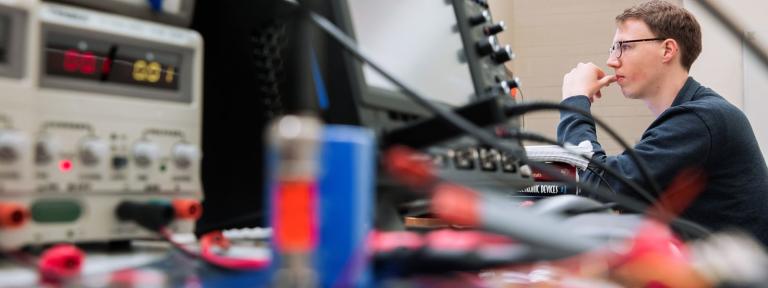
Some might question the practicality and purpose for the existence and use of a Rube Goldberg contraption. Any highly complex mechanical device that performs what appears to be a perfunctory, overly simple task is, well, open to exhaustive scrutiny and questioning.
But for Kettering University Electrical and Computer Engineering Professor Ken Kaiser, the design of a Rube Goldberg contraption offered students in his capstone class an opportunity to use electrical and mechanical engineering theories and their co-op experiences in a new and fun way.
The class was Electrical Engineering 490: Senior Electrical Engineering Design Project for the summer 2007 term and the primary objective given at the start of class was to design, implement, document and present a device or system as a significant capstone project by the end of the term.
Specifically, the project emphasized electrical engineering but as Kaiser noted, "it's multidisciplinary-the project must meet various realistic specifications. Designs were required to adhere to applicable engineering standards, including safety economic factors." He also said that the ECE Dept. provided each student team (made up of three or four students) approximately $300 to complete the project. To complete the project, teams had to use and build upon the knowledge they gained at both Kettering and their co-op positions.
According to Kaiser, all five teams "did a superb job. They met all the requirements of the project within 10 weeks, which is a challenging task."
Kim Merrill, a senior III Electrical Engineering major from Bailey, Colo., and a team member, said that at first, "the Rube Goldberg challenge seemed simple and straight forward. But, when it came to combining all the individual circuits, motors and mechanical motions, it was weeks of all afternoon, all night, and early morning debugging, rebuilding, and perfecting. At the end of the term, when you're standing with your friends in the Great Court explaining the sequences and how long it took to do this or that, or what part blew up the day before a milestone, all the sleep deprivation is replaced with a strong sense of pride and accomplishment."
Although most Rube Goldberg contractions typically emphasize mechanical operations and focus less on electrical devices, Kaiser instructed students to do the opposite: emphasize electrical aspects. The guidelines for each project required the use of more than 30 electrical elements such as microprocessors, ultrasonic sensors, heat sinks and metal-liquid switches.
"Another important aspect is the documentation describing their projects," Kaiser explained. "Instead of a written report, student teams had to label, number and then describe their contraption in similar fashion that museums do with Rube Goldberg contraptions on display," he added.
Once the project was completed, teams took their contraptions to Kettering's Great Court in the Campus Center for display, which drew scores of students, faculty and staff to observe how each one worked. Additionally, Kaiser had each Rube Goldberg contraption video taped and readers may watch these clips by clicking on the following links:
- http://www.youtube.com/watch?v=dxGrVXhFopk;
- http://www.youtube.com/watch?v=G_8EIAGERzE;
- http://www.youtube.com/watch?v=ZPIZfe1R6c4; and
- http://www.youtube.com/watch?v=1fWj_JLCx-k.
| In 2006, Kaiser assigned student teams to develop a similar project by constructing and turning doll houses into haunted houses. The results were quite astounding. These houses featured monsters, ghosts and other attributes associated with haunted houses, including sound characteristics of squeaky doors, elongated moans and blood curdling screams. To view a video of the 2006 haunted house projects, click here.
And for 2008, Kaiser expects to engage students in a similar project that is yet to be determined. "Although it's a lot of work," he said, "Students find a great deal of satisfaction in applying electrical engineering principles to a project that is both fun and rewarding." |
Written by Gary J. Erwin
810-762-9538
gerwin@kettering.edu